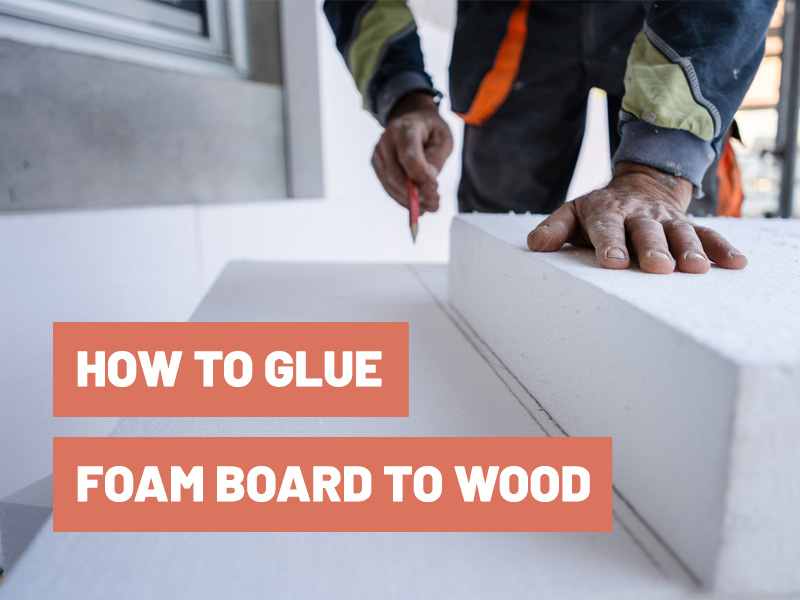The key to gluing foam board to wood is adhesive. For this specific project, you need heavy-duty glue:
- Polyurethane construction adhesive
This adhesive is designed specifically for foam boards, causing the foam board to glue to the wood very strongly and to hold a tight bond long-term.
Plus, this specific adhesive is compatible with all types of wood, including plywood.
The foam board usually absorbs all other adhesives, making it difficult to glue it to wood (or anything else) with a stronghold.
You will also need:
- A 2-inch sponge
- An 80-grit sandpaper
You can glue foam board to wood in a few simple steps once you have the right adhesive for this project:
- Measuring
- Cleaning and preparing the surfaces for gluing
- Applying the foam insulation glue
- Waiting for the adhesive to dry and cure
See? In four easy steps, you can get your project done.
Before we begin, here is a helpful tip. If your foam board, for any reason, won’t lay fully flat, use weights to level it out. Keep it weighed down until the glue fully cures.
Continue reading to discover exactly what you need to do in each step to get this project done like a pro.

Step One: Measure And Cut Accordingly
Before you get too excited about this project and woop out your adhesive to start gluing, you must ensure that everything is the size it needs.
This step is very easy but key:
- Measure the wood
- Cut the foam board to match the same measurements of the wood
Step Two: Clean And Prepare The Surfaces
If there is dirt, dust, grease, debris, or anything like it on the surface of your wood or foam board, the adhesive won’t be able to create and keep a tight hold.
So here is what you need to do to prevent this from happening:
- Mix liquid dish soap in warm water
- Use a clean towel, rag, or cloth to dip in the soapy water
- Wipe down all the surfaces that will be glued – both the wood and foam board
- Let them fully dry
If you are in a bit of a hurry, you can speed up the drying time by improving airflow in the area.
Open up a window, use a fan, or turn on a hair dryer to point directed and increased airflow to your wood and foam board.
Step Three: The Bonus Step Before Gluing
Surprise, there is a bonus step! Don’t worry, it isn’t anything complicated, but it can help you get an even stronger bond after you glue the foam board to wood.
If the surface of your wood is extremely smooth, or if it has a coating of glossy finishing on it, the adhesive will have a harder time creating a very tight bond as it won’t have an abrasion to hold onto.
Use rougher sandpaper (about 80-grit) to roughen up the surface of the wood and create the abrasion the glue can tightly hold onto.
Step Four: Apply The Polyurethane Construction Adhesive
It is time to glue.
- Apply the adhesive to wood
- Use a soft sponge, a small paintbrush, or something similar to evenly spread the glue across the wood.
- Apply the same adhesive to the side of the foam board that will be glued to the wood
- Gently press the foam board against the wood
- Apply even pressure
- Hold it until the adhesive dries (for about 20 minutes), then press down on it more firmly.
Step Five: Wait For The Adhesive To Fully Dry And Cure
Drying and curing times are not the same.
Insulation adhesive can take only a few minutes to dry or as long as 10-20 minutes, depending on the temperature and airflow in the room.
Higher temperatures (heat) cause the glue to dry faster. So does an increased airflow.
Curing takes even longer.
With most adhesives, the full curing time can take up to 24 hours. It is recommended to keep in place, secured, your projects during this time. You can use clamps to achieve this.
Conclusion
Gluing foam board to wood requires a strong-duty adhesive that can create that tight hold you need.
Foam board can absorb most glue types, so you need one that will work well with it despite this characteristic.
One of the best adhesives for this project is Polyurethane construction glue.
To get this project started and finished, you only need to take a few simple steps. These are:
- Measuring and cutting
- Cleaning and preparing the surfaces for gluing
- Applying the foam insulation glue
- Waiting for the adhesive to dry and cure
Which glue is safe to use on foam boards?
There are multiple adhesives you can use on your foam, adhesives that won’t damage foam boards or cause them to dissolve.
Here is a list of the most common ones:
Foam construction adhesive:
– Loctite PL 300 Foamboard VOC Latex Construction Adhesive
– Loctite Power Grab All Purpose Construction Adhesive
– Liquid Nails LN604 Projects And Foamboard Adhesive
Other types of adhesives:
– Great Stuff Insulating Foam Sealant
– Original Gorilla Glue
– 3M 30NF Green Fastbond Contact Adhesive
Can I glue foam board to wood with rubber adhesive?
Rubber glue isn’t compatible with foam, so we don’t recommend its use for this project.
Can I use silicone for insulation?
Yes. Silicone matches well with insulation offering a tight hold.
It also offers you flexibility, allowing you to adjust the material if needed while it is still drying.


